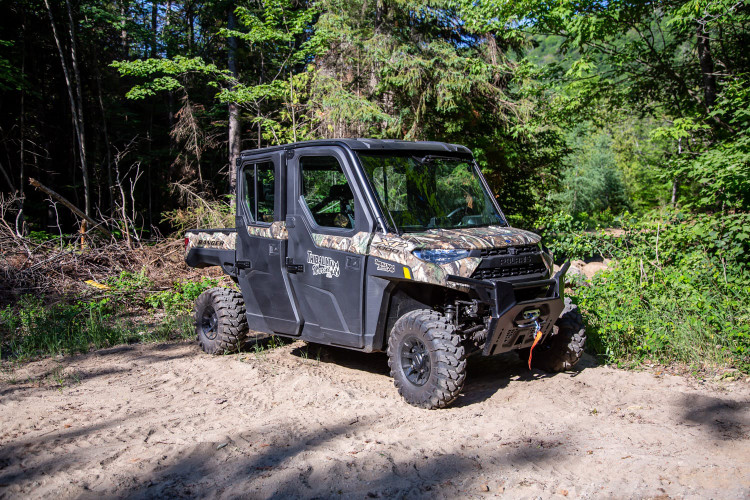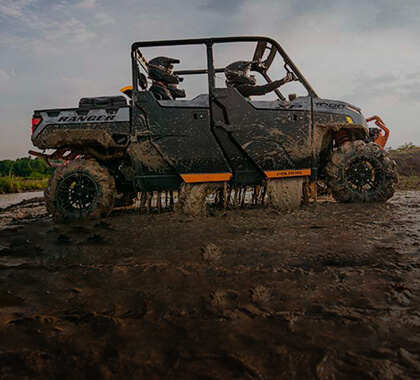10 Frequently Asked Questions About the Polaris Ranger
May 15th 2023
Question 1: How much is a Polaris Ranger?
Answer 1: The cost of a new 2023 Polaris Ranger can be as low as $11,699 for the Ranger SP 570, or as high as $34,399 for the Ranger XP 1000 NorthStar Edition Trail Boss. Used Polaris Rangers can cost much less, but they may require some work, and you should know what to look for so that you don’t make a bad investment.
Question 2: What type of coolant should you use in a Polaris Ranger?
Answer 2: The owner’s manual recommends Polaris-branded Antifreeze 50/50 Premix, but you can also use Stay Frosty Hi-Performance Formula Coolant by VP Racing.
Question 3: How do you start a Polaris Ranger?
Answer 3: To start a Polaris Ranger, put the key in the ignition, engage the brake pedal, and turn the key in a clockwise direction. Push the shifter knob to the desired gear (High, Low, etc.) and select the desired mode with the button switches just to the left of the shifter (4WD, 2WD, and Turf Mode).
Question 4: How do I open the Polaris Ranger Hood?

Answer 4: To open the hood of the Polaris Ranger, find the hood latch lever above the grill and push it to the left (towards the passenger side of the vehicle). The hood will then become free to pivot upwards, and you can fold it all the way back until it stops.
Question 5: What is considered high mileage for a Polaris Ranger?
Answer 5: With off-road machines like the Polaris Ranger, it’s less about the mileage numbers, and more about the types of miles that were put on it, and whether or not proper maintenance was conducted. Any experienced rider would rather buy a well-taken-care-of Ranger with 10,000 miles on it that was used on blacktop over a swamp buggy with only 1,000 miles. If you don’t pretend like your Ranger is a submarine or trophy truck, you should easily get 10,000 miles out of it. And if you change the fluids / filters often, grease the zerks, and keep up with the periodic maintenance schedule outlined in the owner’s manual, it’s possible to get 20,000-25,000 miles out of a Polaris Ranger.
In general, however, you can think of a Ranger with 15,000 miles like a car with 225,000 miles. Although it’ll likely need new bearings and bushings, and perhaps some replacement yokes and output shafts, if you or the previous owner was nice to the machine, it should keep on chugging long past the 10,000 mile mark.
Question 6: What is the width of a Polaris Ranger?
Answer 6: The width of a Polaris Ranger varies between 48 inches and 65 inches. The widths of each Polaris Ranger model are listed below:
- Polaris Ranger Crew 1000 - 62.5”
- Polaris Ranger 1000 - 62.5”
- Polaris Ranger XP 1000 EPS - 62.5”
- Polaris Ranger Crew XP 1000 EPS - 62.5”
- Polaris Ranger XP 1000 High Lifter Edition - 65”
- Polaris Ranger Crew XP 1000 High Lifter Edition - 65”
- Polaris Ranger XP 1000 NorthStar Edition - 65”
- Polaris Ranger Crew XP 1000 NorthStar Edition - 65”
- Polaris Ranger XP 1000 Texas Edition - 62.5”
- Polaris Ranger XP 1000 Trail Boss - 62.5”
- Polaris Ranger XP 900 - 60”
- Polaris Ranger Crew XP 900 - 61”
- Polaris Ranger 800 - 60”
- Polaris Ranger Crew 800 - 60”
- Polaris Ranger 800 Mid-Size - 58”
- Polaris Ranger 570 Full-size - 60”
- Polaris Ranger Crew 570 Mid-Size - 60”
- Polaris Ranger 570 Mid-Size - 58”
- Polaris Ranger 500 - 58”
- Polaris Ranger 400 - 56.5”
- Polaris Ranger 6x6 - 60”
- Polaris Ranger 150 EFI - 48”
- Polaris Ranger EV - 58”
- Polaris Ranger ETX - 58”
- Polaris Ranger Diesel - 60”
- Polaris Ranger Crew Diesel - 61”
- Polaris Ranger Diesel HST Deluxe - 64”
Question 7: How do you check the engine codes on a Polaris Ranger?

Answer 7: To see the specific error code after your vehicle’s check engine light has turned on, simply hit the button on the display until it says check engine, and then hold the button down until the code pops up. You can then look that code up in the manual, on Google, or at this detailed walkthrough of Polaris Ranger error codes to find out more.
On older model years, you can check the engine codes on your Polaris Ranger by doing what is colloquially known as the “key dance”. Starting with the key in the off position, click it on and off rapidly three times (off-on-off-on-off-on) and end with the key in the on position. Your digital instrument cluster should say “wait”, and after a few seconds it will show the codes.
Checking the engine codes on your Ranger are only required when the square engine light (CEL) becomes illuminated. If the wrench-looking light comes on, this is a service reminder, not a CEL. If you tried the key dance and you still don’t see the code, there’s likely an issue with the gauge or PCM, and you’ll want your dealer to scan it with their diagnostic machine to confirm.
For intermittent CEL illuminations that come and go, you’ll want to catch it when the light is on. If your CEL comes on, goes away, and then never comes back, it could be that your belt slipped, water got into a harness, or you’ve got some faulty wiring somewhere.
Question 8: How Does the Polaris Ranger compare to the Can-Am Defender?
Answer 8: If you ask a Ranger or Can-Am fanboy, you’re sure to get a different answer as to which machine is better. But in all actuality, they’re both great machines, and you can’t go wrong with either. Many riders think that the Defender has a nicer interior, with more comfortable seats and extra space, a higher-quality fit and finish, and better ergonomics overall. Other riders hate the Defender’s interior, claiming that many of the elements seem cheap and poorly executed, and that the cab is louder and hotter due to the position of the engine.
Factors like price, availability, and access to parts / accessories are also worth considering. The Ranger is easier to work on – with more room under the hood – and you can change the oil, swap out the belt, and conduct clutch maintenance without having to be an expert.
You’ll always encounter model-specific problems and issues with individual machines regardless of the brand. Plus, you can’t really compare any Ranger to any Defender, as the XP Rangers are quite different than the non-XP Rangers, and the Defender varies widely between, say, the HD7 and the HD10.
One thing that riders like about the Polaris Ranger is that even with a base model, you get a true locking front differential. With the Defender, you have to pony up for the XMR package to get a legit locking front diff. The shifting and transmission are arguably smoother on some Defender packages compared to some Ranger packages, but if you use your rig to hunt, the bed drains on Can-Am Defenders are right above the exhaust, and blood plus a hot exhaust is a bad combination. For many riders, it all just boils down to either price, or the quality / reliability of the respective dealers in their area. At the end of the day, though, it’s a Ford Vs Chevy type of question, and you’ve gotta do your own research to see which vehicle, edition, and trim package is right for you and your specific needs.
Question 9: How do you adjust the shocks on a Polaris Ranger?
Answer 9: Although you can adjust the front and rear shocks of your Polaris Ranger with the spanner wrench included in the factory tool kit by moving the top shock mounting bolts from the inside to the outside mounting holes (ensuring to reinstall them at 40 ft-lbs of torque), we’d suggest instead using a pipe wrench or a big set of channel locks to avoid busting your knuckles.
Start by jacking up the vehicle all the way off the ground to take the weight off the shocks, and then spray some lube / PB Blaster on them to wash out all the dirt between the adjusters and shock body. If you do decide to use the stock spanner wrench, wear gloves to save your hands. Use one hand to hold the spanner wrench in place, and the other had to turn the spanner wrench. Make sure to adjust the suspension on both sides of the vehicle, and if you stiffen up your suspension to handle a heavy load, adjust it back down for better stability after the load is removed.
Question 10: Where is the best place to get Polaris Ranger accessories?
Answer 10: Everything Polaris Ranger!


